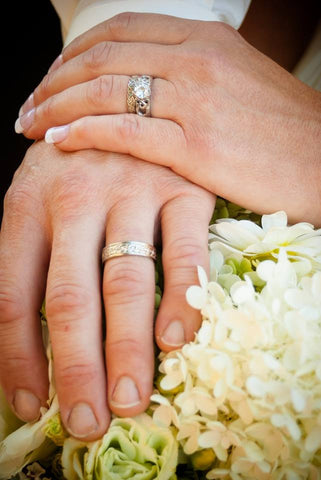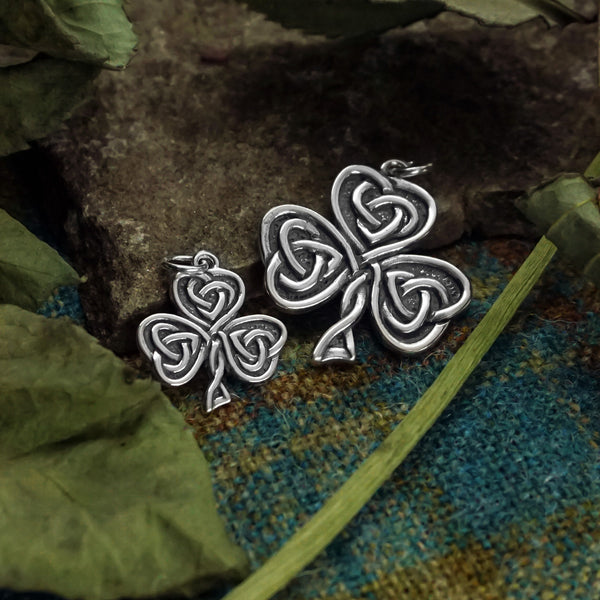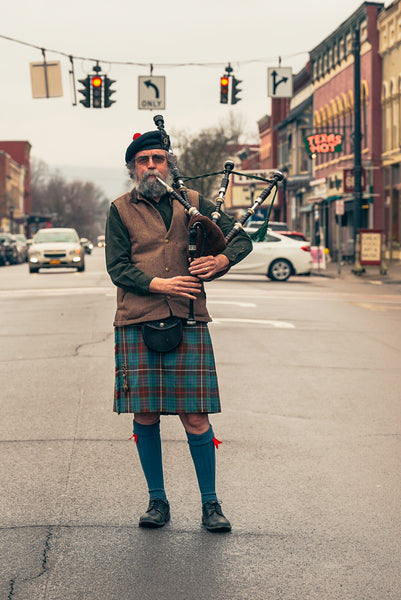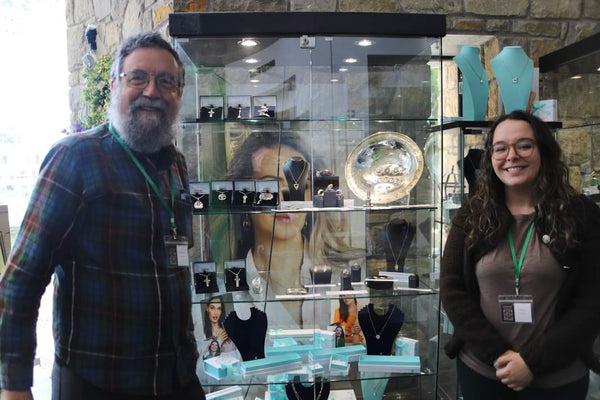- Jewelry
- Crosses
- Rings
- Mens
- Claddagh
- Wedding
- Personalized Jewelry
- John Urban Jewelry
- Sale
- Gift Certificates
- About Us

Celtic Jewelry is an excellent way to express your heritage as part of your wedding. Rings are the central prop in the wedding ceremony. Celtic design wedding rings are a way that your heritage can be displayed daily for the rest of your life. There is also a rich tradition of using brooches as betrothal gifts. Earrings, pendants or brooches make excellent gifts to bride’s maids. They are sentimental reminders of the wedding that can be worn by the recipients in the for the rest of their lives. Traditional men’s jewelry items such as cuff links, kilt pins, tie tacks or belt buckles can be given as attendant gifts to the best man and groomsmen.

Symbolism of the Celtic wedding ring. Rings that display Celtic knotwork are becoming increasingly popular choices for wedding rings. The circular shape of the wedding ring, since it has no beginning nor end, is a symbol of endless love and devotion. The endless strand of the Celtic knot is also a symbol of eternity and is a beautiful compliment to the symbolism of the ring itself. The crossing of the strands of the knot represent the inter-woveness of our lives. Many designs link repetitions of knots with continuous strands linking each to the next. The meanings of these designs are not a strict symbolic language but are open to interpretation. You may think of the continuum of repetitions as representing an unbroken chain of generations. The interlace can represent the way in which the lives of the bride and groom are to be intertwined. Heart knots of course represent love.

There are very few knots that can be said to be specifically Scottish, Irish, or Welsh. Knotwork as an element of Celtic design originates in the early Christian period, fourteen hundred years ago. At that time what we now call Celtic art was an international style that spread with the influence of Irish missionaries to Scotland, Wales and beyond. It is only in the past three hundred years that these designs began to be considered emblematic in a nationalistic way. The way that Celtic design identifies the wearer with a Celtic heritage is another very powerful reason for choosing a Celtic ring.
Choosing a ring.
We practice the craft of designing and producing Celtic jewelry. Our endeavor is to provide both the highest standard of craftsmanship as well as authentic and meaningful design. We know that other suppliers are only a click away on the web, so whether you choose our rings or others we humbly offer these suggestions.

Many Celtic rings have been given names either by their designers or by clever marketers. Names such as the "Lover’s knot" or "the Eternity knot" each sound as if they must be a very specific design with a traditional legacy. In fact, any of the Celtic knots can be said to share the sentiments of either of these names or many others. It would be a mistake to base your choice of a ring on what the supplier chooses to call it. Choose instead based on how it looks and what the design means to you as you seek significance in the design. If you choose a knotwork ring, be sure that there are no mistakes in the alternation of over and under crossings of the cord and look out for short cuts in design made for the sake of sizing. Some designers handle the sizing problem in ways that do not aesthetically or symbolically compromises the design. Others who do not fully understand the significance of the design butcher them for the sake of sizing.

Celtic wedding bands do come in sets with diamond engagement rings. To show Celtic design on a ring, a certain amount of width is needed. Many brides feel that two such bands on the same finger is too much. Many solitaire diamond rings will go very well with straight sided Celtic bands. For others, the set is preferred. In addition to the alternative of wearing a solitaire alongside of a Celtic band some people choose to have just one ring with a stone to serve as a wedding ring. The engagement ring is a rather modern concept. In the old days brooches were common as engagement or betrothal gifts.
Claddagh Rings, [ klah dah] or less comonly [klay dah]

These rings date from the 17th century. Two hands clutching a heart are for friendship, the crown for loyalty or fidelity and the heart symbolizes love. Claddagh rings have become very popular in recent decades especially among the Irish. There is a custom of wearing it on the right hand facing out if the wearer is single and not spoken for or facing inwards on the right hand to signify that there is a sweetheart. On the left hand, the ring worn outward is an engagement ring and at the wedding it is turned inwards to signify the final devotion of the heart in marriage. Claddagh brooches, earrings, buckles, tea towels and practically anything else are now on the market. The Claddagh is a beautiful symbol with a quaint heritage but unfortunately it is becoming cliched and over used.
Brooches were important for fastening garments in earlier times and are still used in that way, especially for women’s scarves or plaids. A plaid, pronounced so that it rhymes with "maid", is a tartan sash or cloak worn by either sex. When worn by a man it is usually with a kilt. Scottish weddings frequently include the custom of the groom pinning a plaid of his clan tartan on his bride as part of the wedding ceremony.

Scottish couples may want to feature Clan badge jewelry in their wedding.
There are several types of brooches that are of specific interest to someone planning a wedding. The Luckenbooth brooch is a traditional piece of jewelry that takes it’s name from the "locked booths" were they were sold in Edinburgh in the 16th and 17th centuries. The design, very much like the Claddagh, incorporates the heart and crown. There are many variations, often two hearts are intertwined or in some examples the hearts are formed of a stylized letter "M". The origin of the design came from the royal monogram of Mary Queen of Scots. A luckenbooth brooch is frequently used as a love token because of the heart motif. There is a superstition that a luckenbooth brooch pinned to a baby’s blanket will protect it from the evil eye or from fairie mischief. Curiously, in 18th century North America the luckenbooth brooch was adopted by Iroquois Indians who traded for them and copied them from Scottish settlers on the frontiers and from Highland soldiers that were involved in the French and Indian War.

Some traditional Celtic brooch forms that are enjoying renewed use are the annular and the penannular brooches. The terms for these brooches are frequently confused. These brooches are designed with the pin crossing a circular opening so that it works rather like a belt buckle. The penannular brooch has a break in the ring so that the pin may pass through and be twisted to lock it. The annular or ring brooch is more secure and works by pulling a gather of cloth through the center and then pinned through. People who delight in old fashioned and authentic accessories prefer these. Many people find these brooch forms awkward to attach and so they are often now made (shudder!) with fixed pins and modern safety catches on the back. The most famous Celtic brooch is the Tara Brooch, now in the Irish National Museum. The Tara Brooch is actually a pseudo-penannular brooch. It looks like a penannular in its shape but since the ring is solid it cannot attach in the same way.

Medieval annular type designs influenced later plaid brooches in that they are frequently round. Men’s plaid brooches are usually about two inches in diameter in Scotland. The larger "piper’s" brooches are three or four inches and frequently are decorated with a large gemstone. This stone is most commonly a tea colored "Cairngorm" which is a quartz found in the Highlands. Authentic Cairngorms are no longer available and citrine or smoky quartz are substituted, usually from an imported source.
Comments will be approved before showing up.


Thousands of photographs were taken. Help find at least one.
Were you a tourist in London, Dublin or Paris in 1975 – 1978? Did you see a street performer playing bagpipes? Did you take his picture? Was it Steve Walker? If you can share that picture with Walker Metalsmiths you could score some sweet Celtic jewelry.
